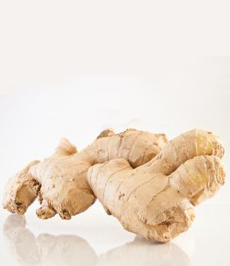TIP OF THE DAY: Use Fresh Ginger Root
|
Today’s tip is from Chef Johnny Gnall:
Ginger is a terrific flavor, adding exotic sweet and floral notes and a spicy kick to any number of cuisines and recipes. It is equally adaptable to sweet and savory foods. In your kitchen, is the ginger always powdered in a shaker jar? Or do you head to the produce aisle for a piece of fresh ginger root? Dried ginger has its place, but doesn’t hold a candle to the vibrant flavors of raw, fresh ginger. From Vietnamese spring rolls to slow-cooked stews with braised pork and big hunks of raw ginger (not to mention, pickled ginger with sushi), the root is where it’s at. Dried ginger in the spring roll would be just too sharp; and in the stew it would not have the roundness it needs to develop. So today’s tip is: Cook with fresh ginger. |
|
|
|
To start you off, here’s a delicious recipe for honey ginger carrots. If you have kids, Try baby carrots (actual miniature carrots, not the whittled-down thumbs sold in plastic bags), and serve them like sweet little chicken fingers. We promise they will get gobbled up. HONEY GINGER CARROTS RECIPE Ingredients 3. Reduce heat a bit more and add the honey, then the carrots, stirring continuously. If things get dry, reduce the heat and add a touch of butter or a very small amount of water. 4. Once the carrots are coated and the water has evaporated, remove from heat and transfer to a dish. Toss in the chopped parsley and lavender. Then chow down. Fridge. Wrap the ginger in a paper towel, then place it in a plastic storage bag. It should stay fresh in the crisper drawer for up to three weeks. Freezer. If you’re not going to use the ginger soon, freeze it. We peel and freeze slices that quickly defrost (or, just pop the frozen slices into the dish you’re cooking). Another option is to peel and grate the root with a microplane grater. Set a sheet of plastic wrap on the counter and spoon the ginger in a vertical line. Roll up the plastic, twist the ends and freeze. When you want some ginger, unwrap the plastic and break off a chunk. It defrosts quickly. Native to Southeastern Asia, ginger has been used for more than 5,000 years in Chinese medicine. The oils in fresh ginger cause the stomach to produce more digestive enzymes, which help to neutralize stomach acids and relieve diarrhea, heartburn, nausea and stomach cramps. Slices of fresh ginger in hot water make a very soothing ginger tea that clears the sinuses as well. Ginger has also been shown to help in blood circulation and anti-clotting, as well as lower cholesterol levels. It may also be an anti-carcinogen and provide relief from migraine headaches. The ginger plant, Zingiber officinale, is a rhizome, a plant with a horizontal, often underground, stem that is edible (although the leaves are often eaten as well). While we call it a root, it’s actually a stem. Here’s more on the healthfulness of ginger, one of the seven highest anti-oxidant spices.
|
||


